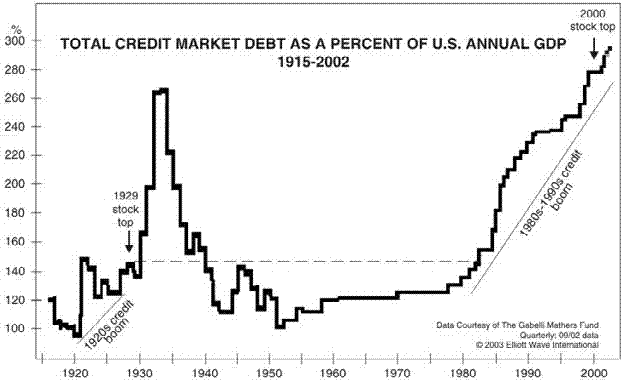By Elliott Wave International
Telegraph.go.uk, May 26: "US money supply plunges at 1930s pace… The M3 money supply in the U.S. is contracting at an accelerating rate that now matches the average decline seen from 1929 to 1933, despite near zero interest rates and the biggest fiscal blitz in history."
Deflation is suddenly in the news again. It's a good moment to catch up on a few definitions, as well as strategies on how to beat this rare economic condition.
And who better to ask than EWI's president Robert Prechter? He predicted the first wave of deflation in the 2007-2009 "credit crunch" and has written on this topic extensively.
We've put together a great free resource for our Club EWI members: a 63-page "Deflation Survival Guide eBook," Prechter’s most important deflation essays. Enjoy this excerpt — and for details on how to read the eBook in full free, look below.
What Makes Deflation Likely Today?
Bob Prechter, Deflation Survival Guide, free Club EWI eBook
Following the Great Depression, the Fed and the U.S. government embarked on a program…both of increasing the creation of new money and credit and of fostering the confidence of lenders and borrowers so as to facilitate the expansion of credit. These policies both accommodated and encouraged the expansionary trend of the ’Teens and 1920s, which ended in bust, and the far larger expansionary trend that began in 1932 and which has accelerated over the past half-century. Other governments and central banks have followed similar policies. The International Monetary Fund, the World Bank and similar institutions, funded mostly by the U.S. taxpayer, have extended immense credit around the globe.
Their policies have supported nearly continuous worldwide inflation, particularly over the past thirty years. As a result, the global financial system is gorged with non-self-liquidating credit. Conventional economists excuse and praise this system under the erroneous belief that expanding money and credit promotes economic growth, which is terribly false. It appears to do so for a while, but in the long run, the swollen mass of debt collapses of its own weight, which is deflation, and destroys the economy. A devastated economy, moreover, encourages radical politics, which is even worse.
The value of credit that has been extended worldwide is unprecedented. Worse, most of this debt is the non-self-liquidating type. Much of it comprises loans to governments, investment loans for buying stock and real estate, and loans for everyday consumer items and services, none of which has any production tied to it. Even a lot of corporate debt is non-self-liquidating, since so much of corporate activity these days is related to finance rather than production.

Figure 11-5 is a stunning picture of the credit expansion of wave V of the 1920s (beginning the year that Congress authorized the Fed), which ended in a bust, and of wave V in the 1980s-1990s, which is even bigger.
…it has been the biggest credit expansion in history by a huge margin. Coextensively, not only is there a threat of deflation, but there is also the threat of the biggest deflation in history by a huge margin. …
- What Triggers the Change to Deflation
- Why Deflationary Crashes and Depressions Go Together
- Financial Values Can Disappear
- Deflation is a Global Story
- What Makes Deflation Likely Today?
- How Big a Deflation?
- Much, Much More
This article was syndicated by Elliott Wave International. EWI is the world's largest market forecasting firm. Its staff of full-time analysts lead by Chartered Market Technician Robert Prechter provides 24-hour-a-day market analysis to institutional and private investors around the world.
I have even more encouraging news to rreopt than your highly encouraging rreopt that Spring is on its way, Two Cents. I believe that the next Spring will be a permanent Spring.I agree 100 percent that it is important to understand the concept of Stock Cycles. Those who don’t get it that stock prices move in cycles don’t understand how stock investing works (I of course mean no offense to anyone with these words).The problem with Stock Cycles is that they have grown too large. As our wealth has expanded, higher and higher percentages of the population have invested in stocks. We are in a situation today where the Summer cycle caused such insane levels of overvaluation that it is going to take something extraordinary (the power of the internet!) to keep us from going over a cliff in this Winter cycle. We can never, ever, ever again permit a Summer cycle like the one we just lived through.I believe that we are today on the threshold of the biggest advance in our understanding of how stock investing works in history. We are soon going to be able to teach people about how Stock Cycles work and about how they should invest given the reality of Stock Cycles.Guess what that means? It means no more Stock Cycles! There can never again be insane overvaluation once the majority of investors have a means of learning of the dangers of insane overvaluation. Once people learn the realities, they will lower their stock allocations at the first sign of overvaluation and the selling will bring prices back to fair value. It will be never Winter and always Christmas!There was no electricity until some smart human discovered it. There was no British Invasion until John Lennon struck up a conversation with Paul McCartney. Cynics point out that bad stuff happens from time to time. True. They too often fail to note that wonderful stuff also happens from time to time and, like the bad stuff, often when we least expect it. The bad stuff often CAUSES the wonderful stuff because it is experiencing the bad stuff that gets us all off of our duffs and out looking about for electricity and beats you can dance to and ideas for bringing Stock Cycles to a permanent stop.Rob